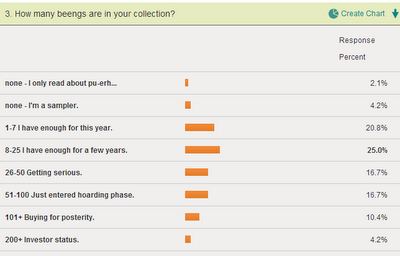I asked in my first reader survey how much you were willing to shell out for the "world's best young sheng". The chart below shows a third of you are reasonably budget minded while the other third of you are the kind of high-rollers pu-erh vendors salivate over. The arithmetic average is $115 while the
average mean and mode were both on a clean Benjamin ($100). A few respondents refused to answer not wanting to give vendors such useful market data. What you are theoretically willing to pay on a survey is quite different than actually peeling forth those dollars in real life. (Drats I should have asked what maximum amount people have already paid...)
Where am I on that curve? My wallet being curiously unopinionated never bothers to thank me or curse me so I have to rely on comparative living costs to orient myself. Even $200 for a 357g beeng computes to only $1.68 per session for me. My mini-pots use 2-3g of tea for a session so 357g/3g = 119 sessions or $200/119=$1.68. Less than two bucks for me theoretically should not be too much for the "world's best" since I drink $1.75 canned coconut waters rather casually on a weekly basis after my runs. I'm a bit bummed that I've spent over $1000 on coconut water but it's way cheaper than a gym membership. However I still balk at even parting with $100 on a new sheng. But I have also yet to meet this mind-blowing "world's best" newborn despite my diligent attempts.
Fungibility of money is one of the most mind boggling achievements of human civilization. An hour of massage not covered by insurance is around $100 including tip in the bay area - legitimate therapeutic licensed massage that is. I thought nothing of buying two tickets to Aida yesterday for $190 for 3 hours of unparalleled operatic pageantry at the Met- actually I was happy to find such reasonable tickets. A $100 high end beeng can bring you over a hundred hours of drinking pleasure. Why do I and a fair amount of the respondents share this mental block of going over $100 on a young sheng? I'll leave that for discussion tonight. Good night!
Where am I on that curve? My wallet being curiously unopinionated never bothers to thank me or curse me so I have to rely on comparative living costs to orient myself. Even $200 for a 357g beeng computes to only $1.68 per session for me. My mini-pots use 2-3g of tea for a session so 357g/3g = 119 sessions or $200/119=$1.68. Less than two bucks for me theoretically should not be too much for the "world's best" since I drink $1.75 canned coconut waters rather casually on a weekly basis after my runs. I'm a bit bummed that I've spent over $1000 on coconut water but it's way cheaper than a gym membership. However I still balk at even parting with $100 on a new sheng. But I have also yet to meet this mind-blowing "world's best" newborn despite my diligent attempts.
Fungibility of money is one of the most mind boggling achievements of human civilization. An hour of massage not covered by insurance is around $100 including tip in the bay area - legitimate therapeutic licensed massage that is. I thought nothing of buying two tickets to Aida yesterday for $190 for 3 hours of unparalleled operatic pageantry at the Met- actually I was happy to find such reasonable tickets. A $100 high end beeng can bring you over a hundred hours of drinking pleasure. Why do I and a fair amount of the respondents share this mental block of going over $100 on a young sheng? I'll leave that for discussion tonight. Good night!


















